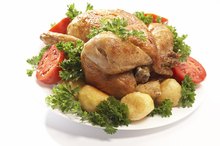What does fact checked mean?
At Healthfully, we strive to deliver objective content that is accurate and up-to-date. Our team periodically reviews articles in order to ensure content quality. The sources cited below consist of evidence from peer-reviewed journals, prominent medical organizations, academic associations, and government data.
The information contained on this site is for informational purposes only, and should not be used as a substitute for the advice of a professional health care provider. Please check with the appropriate physician regarding health questions and concerns. Although we strive to deliver accurate and up-to-date information, no guarantee to that effect is made.
Vitamin K-2 Food Sources
Vitamin K-2, also known as menaquinone, isn't as commonly found in foods as vitamin K-1, or phylloquinone. It is mainly found in animal products, and the bacteria in your intestines can also produce it. This form of vitamin K may be better for keeping your bones strong and limiting your risk for osteoporosis than vitamin K-1, according to an article published in "Alternative Medicine Review" in March 2005 5. Women need 90 micrograms per day of vitamin K for proper blood clotting, and men need 120 micrograms per day.
Chicken and Vitamin K-2
Poultry is one of the better sources of vitamin K-2. For example, a 3-ounce serving of chicken breast with the skin has 12.4 micrograms, and the same amount of dark meat from a chicken thigh with the skin contains 10.2 micrograms. Skip the skin and eat a rotisserie chicken thigh, and you'll be consuming 20.9 micrograms of vitamin K-2. Each drumstick contains 18.9 micrograms.
- Poultry is one of the better sources of vitamin K-2.
- Each drumstick contains 18.9 micrograms.
Beef and Pork
Nutrition Information on Boston Butt Pork Shoulder
Learn More
Beef and pork aren't as high in vitamin K-2 as chicken. A 3-ounce serving of canned pork has 12.7 micrograms of vitamin K-2, and 3 ounces of ham provide about 8.2 micrograms. Eating the same amount of grilled beef chuck will increase your vitamin K-2 intake by 2.6 micrograms, and 3 ounces of grilled bottom round steak have 1.4 micrograms.
- Beef and pork aren't as high in vitamin K-2 as chicken.
- A 3-ounce serving of canned pork has 12.7 micrograms of vitamin K-2, and 3 ounces of ham provide about 8.2 micrograms.
Fish and Seafood
Most types of seafood only provide trace amounts of vitamin K-2. However, a 3-ounce serving of oysters has 4.2 micrograms of this vitamin. The same amount of canned pink salmon provides 0.4 microgram. If you prefer shrimp, 3 ounces will increase your vitamin K-2 intake by 0.3 microgram.
- Most types of seafood only provide trace amounts of vitamin K-2.
- If you prefer shrimp, 3 ounces will increase your vitamin K-2 intake by 0.3 microgram.
Dairy Products and Other Sources
Vitamins & Minerals That Meats Give Us
Learn More
Fermented foods, including cheese and natto, a type of fermented soybean commonly eaten in Japan, also provide vitamin K-2. A tablespoon of cream cheese contains 2.9 micrograms, a cup of whole milk has 2.4 micrograms and 1/2 cup of creamed cottage cheese provides 1 microgram of vitamin K-2.
Related Articles
References
- Food and Agriculture Organization of the United Nations: Vitamin K
- American Cancer Society: Vitamin K
- USDA National Nutrient Database: Nutrient Lists: Menaquinone, Vitamin K
- Linus Pauling Institute: Vitamin K
- Alternative Medicine Review: Vitamin K2 in Bone Metabolism and Osteoporosis
- Vitamin A Fact Sheet for Health Professionals. NIH Office of Dietary Supplements. Updated February 14, 2020
- Sweet potato, NFS. USDA FoodData Central Updated 4/1/2020
- Spinach, cooked, from fresh, fat not added in cooking. USDA FoodData Central. Updated 4/1/2020
- Carrots, raw. USDA FoodData Central. Updated April 1, 2020
- Melons, cantaloupe, raw. USDA FoodData Central. Updated 4/1/2020
- Pepper, sweet, red, raw. USDA FoodData Central. Updated 4/1/2020
- Apricot, raw. USDA FoodData Central. Updated April 1, 2020
- Broccoli, cooked, from fresh, fat not added in cooking. USDA FoodData Central. Updated April 1, 2020
- Institute of Medicine of the National Academies. "Dietary Reference Intakes: Vitamins." http://iom.nationalacademies.org/Reports/2001/Dietary-Reference-Intakes-for-Vitamin-A-Vitamin-K-Arsenic-Boron-Chromium-Copper-Iodine-Iron-Manganese-Molybdenum-Nickel-Silicon-Vanadium-and-Zinc.aspx.
- National Institutes of Health Office of Dietary Supplements. "Vitamin A Fact Sheet for Health Professionals." https://ods.od.nih.gov/factsheets/VitaminA-HealthProfessional.
- United States Department of Agriculture, Agricultural Research Service National Nutrient Database for Standard Reference Release 28. https://ndb.nal.usda.gov/ndb/search.
Writer Bio
Based in Massachusetts, Jessica Bruso has been writing since 2008. She holds a master of science degree in food policy and applied nutrition and a bachelor of arts degree in international relations, both from Tufts University.








